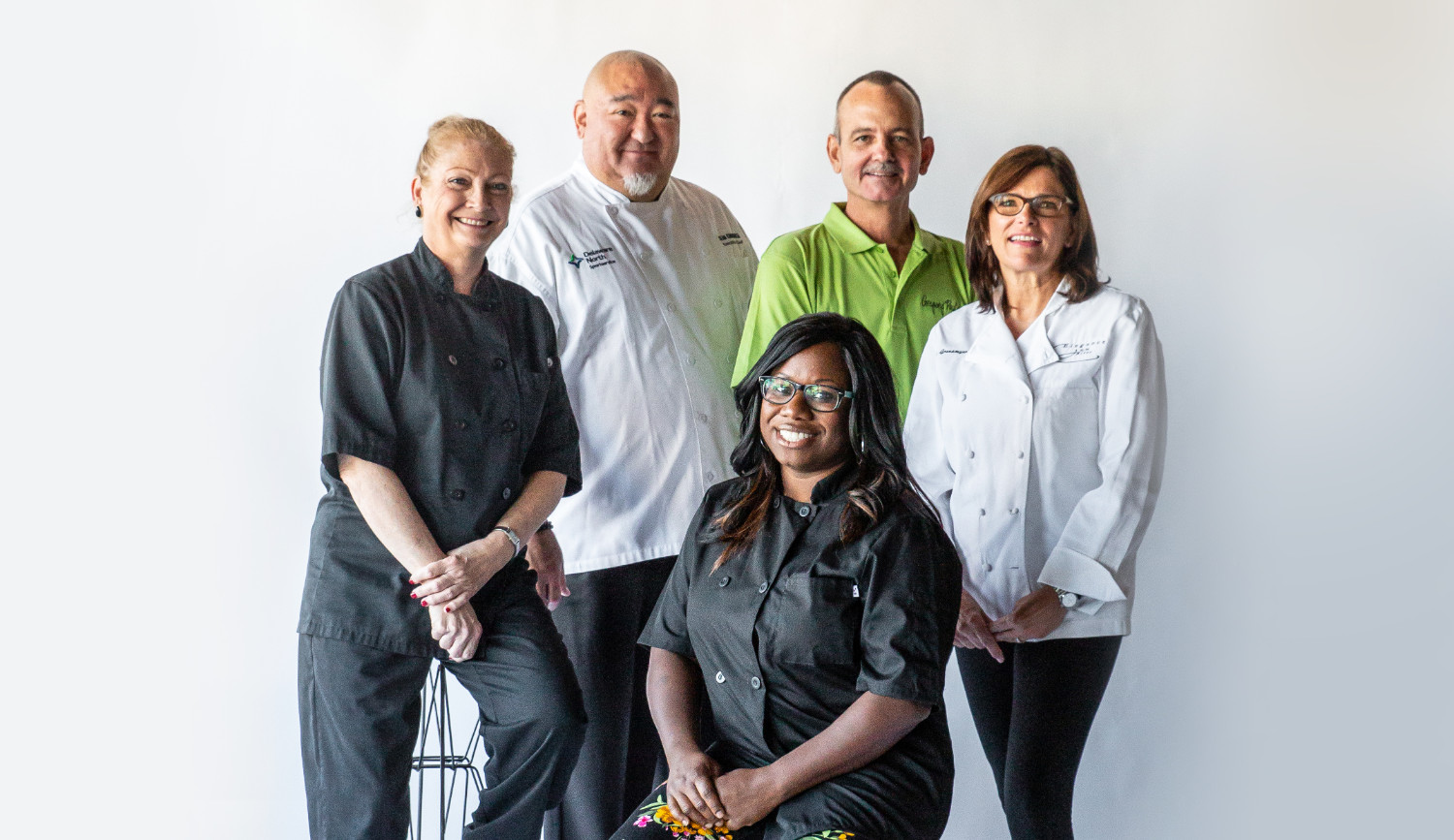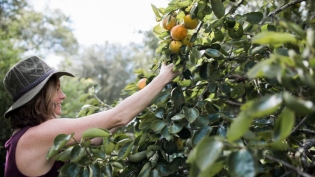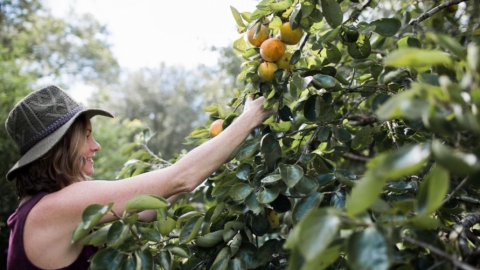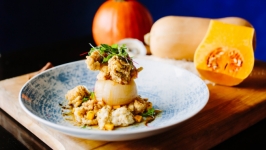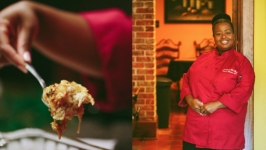Chef's Round Table: Catering in Northeast Florida
Chef's Round Table is a back-of-the-house conversation series where we sit down with local chefs to get an inside look at the questions and conversations taking place in kitchens throughout Northeast Florida. Chefs change with each new round table, as do topics discussed. For the Entertaining Issue, we caught up with the following chefs:
Hope Dempsey, D'Vine Cuisine
Sean Kinoshita, Executive Chef, TIAA Bank Field - Delaware North
Greg Rider, Gregory Paul's
Jasmin Wooden, Blue Sage Cuisine
Liz Grenamyer, Catering by Liz
EDITOR’S NOTE:
As the season of entertaining kicks off, we sat down with chefs working the region’s catering space and learned about the challenges and benefits of creating memorable events in different venues each week. Chefs for this issue were invited to participate based on the following criteria: participants are chefs at local catering companies, who are actively involved in menu development and event planning for their businesses. Criteria will change with each issue and chefs invited to participate will vary. Want to be included in the next discussion or have a chef you'd love to see featured? Drop us a line at editor@edibleneflorida.com.
***********
How does the life of a catering chef differ from a restaurant chef?
LIZ: I’m at home most weeknights. Not that we don’t have events then, but generally they don’t need me there. I’m very lucky to have an amazing team, some of them with me for 25 years. I do work most weekends, especially during the busy season. Most of my chef friends at restaurants work every day, splitting their day to go home mid-day and come back for the evening shift.
SEAN: Same with me. The only time I have to stay late is when we have an event. The challenge we have at the stadium is that our business is part-time seasonal. In December, everybody is done. Come preseason, June through August, we have to do mass hiring and bring on about 275 cooks and dishwashers to staff the stadium. All the good cooks have jobs, so we spend a lot of time training and making sure things are getting done correctly. I pay people as much as I can pay them, and I need them two days out of the month so they have another part-time job and they can plan their schedule around when I need them.
LIZ: To your point, I share some bartenders with you, Sean. They ask me if they can do a gig at the stadium, and I say absolutely. The job pool in Jacksonville has been challenging for a long time. Part of it is because we were a city of chain restaurants for many years. It’s only been recently that we have seen a lot of independent restaurants opening up. Some of the local culinary educators have been trying to bring more talent to the city, but it’s slow going.
GREG: I have been lucky with labor, most of the people have been with me for a number of years, but there are challenges. I was looking for a dishwasher and got no responses. I worked with ARC, a local agency and found someone who is working out. As an owner, you have a sense of urgency, but your staff may not have that same sense of urgency and commitment.
LIZ: People are more transient today, too. I just had three ladies retire and they had been with me for 24 years. You don’t find that much anymore. People change jobs more frequently.
JASMIN: That’s my experience as well. You find staff, they are set, and then our slow season comes in the summer. They have to find work, so when it picks up in the fall you have to start all over again. I have a lot of people who are here for nine months, and then they go to India for a yoga retreat – and they are my best! But they love what they do and are fantastic while they are here. About 40 percent of my team is on the go. Labor’s definitely a tough one.
LIZ: Do you have challenges with the fact that your specialty is vegan and finding people who understand what that is?
JASMIN: Honestly, a lot of my team members are vegan or pescatarian, and subscribe to a low meat diet or frequent the farmers’ market. A lot of my team is not from Jacksonville. Your brand attracts your clientele, and it also attracts your labor pool. We get a lot of people who really believe in what we’re doing.
Since you plan menus for each event, how have menu requests changed over the years?
SEAN: The biggest thing for me has been allergies. People are allergic to everything. We had a banquet the other night and one of the guests came with a list of about 15 different things she was allergic to: carrots, lovage, parsnips, a bunch of other things. I’ve never heard of anyone allergic to lovage.
LIZ: Most people don’t even know what lovage is!
JASMIN: The hardest thing is gluten-free. If you’re making something with flour, that’s challenging to keep separate from other ingredients in the kitchen.
LIZ: We have a lot of gluten-free items in the shop, as I have a lot of clients that request that. When we started getting more customers asking for it, my chef at the time had celiac disease, so he taught us a lot. Now I know a lot about it.
HOPE: One thing we have happen is that guests don’t tell us about allergies in advance. Recently one of our guests was highly allergic to shrimp, and did not tell us. So we had to scramble and shut down one line, clean everything and change gloves to prepare her dinner. That was surprising to me, that the guest did not let the host know in advance.
LIZ: Ethnic foods have also become much more popular.
HOPE: And you never talked barbecue when I first started! You would not have that at a wedding.
What kind of challenges do you have feeding people all at once versus having guests trickle in as they would at a restaurant?
SEAN: I like all at one time because you can control your staff better. Cooks need to be at a restaurant right at the start of the shift, even if it may not get busy until 8 or 9 that evening. Whereas with catering, they are there when you need them, and when you are done, everybody goes – nobody is waiting around to see if you get busy again.
GREG: The challenge can be the timing of getting everything hot when you have multiple courses. Also, you can’t run out of something, like you can in a restaurant. When you are going to an event you need to make sure you bring everything to the location.
HOPE: You can’t forget a spoon!
LIZ: Or any equipment. Sometimes if you don’t do a site visit and test the electric, you can be in trouble. We use induction burners for indoor sauté cooking, you could blow fuses. Sometimes we think we have a kitchen, we are told we have a kitchen, and we really have a room. Or you get into these rooms that are smelly and haven’t been cleaned.
JASMIN: The biggest challenge for me is that the venues are not adequate for food preparation. You may not be able to keep food hot, you don’t have electricity, and even with a site visit you worry about pulling off the event.
GREG: One time we did a small Christmas party at a house the customer had just bought, and the stove didn’t work. Fortunately we knew him, and we were able to run down to a neighbor’s house to finish the cooking.
Are you finding there’s a trend toward more unusual venues?
LIZ: Yes! Venues are being created out of warehouses and other types of unused buildings. It’s a great opportunity to have an event in an interesting space, but the venue is not being prepared to accommodate catering. And heaven help us if we don’t pull it off! Our rule is if our food’s not covered, we can’t do it. Birds, bugs, rodents – I can’t be responsible for birds.
GREG: That’s one of my greatest fears, is someone getting sick.
LIZ: It’s a concern for caterers because the venues may not have proper heating facilities. I have ordered more ovens from rental companies in the last two years than I ever have, because of the venues we have to use.
Do you have organizational tips and tricks from your life as a caterer to pass along to those entertaining at home?
GREG: I would say prep is key.
SEAN: Make sure you have a system to estimate how much food you have, so you don’t run out.
LIZ: We always go over. We overcompensate to make sure we don’t run out. Planning and getting organized is essential. Start two or three days before and make what you can ahead of time.
HOPE: Create a timeline so you are ready an hour before guests arrive.
How about tips for potential clients?
LIZ: One of the things that would be really wonderful is just be honest about your budget. If I can’t do what you want for $25 a head, I would rather just tell you right from the start.
GREG: Yes, because you can work around pretty much anything, if you know in advance.
LIZ: It’s a lot of work creating menus for clients. People don’t always realize there is a person thinking about the menu, it’s not cut and paste.
SEAN: If you are creating the menu based on what they want, the theme, sometimes the request is for local or seasonal. And they may think just because it is local and seasonal it is cheaper, but that’s not always the case.
LIZ: Food costs have gone up more in the last five years more than in the previous 10. Seafood in particular.
HOPE: Seafood’s very expensive. And I always have a disclaimer that if they want fresh fish, they may not get exactly what they request. Also gas costs have skyrocketed – as caterers that is a significant cost. We’re spending more on that.
LIZ: I will say my bottom line, the net has definitely diminished. And this is after 26 years. I don’t know if restaurants feel it, but caterers definitely do. We have to pay our labor, or they don’t stay.
HOPE: And if they stay, they want a pay increase. And they deserve it, because they are loyal. Loyal staff is the best – because you can’t have your family help out all the time.
Let’s talk about sourcing locally and cultivating partnerships with other local businesses. What changes have you seen over the years?
SEAN: The local rice farm Congaree and Penn is partnering with us at the stadium. We will collaborate with other local restaurants as well.
GREG: I have seen several local microgreen farms popping up, and I use them as much as possible. Because I do a weekly menu, I have to be able to get those local products every day. I can’t run out halfway through the week.
LIZ: I love having a lot more locally grown food. Using Congaree and Penn’s middlins to make risotto is great. I love all of that. That’s really changed over the past 10 years. The farmers’ markets are great to see. It’s tough to grow here. Tracy over at Atlantic Beach Urban Farms is terrific, she’ll work with you and grow what you need. And Mr. Bacon is the sweetest! His lettuce lasts forever.
JASMIN: We work with Olive My Pickle and Traders Hill, among other local businesses.
HOPE: We work with Berry Good Farms, they grow a lot of products we use. I would encourage home cooks to explore what is available locally.
Did you plan on being a catering chef?
SEAN: No, I just like to cook, and I like to eat. My dad cooked, he was a cook in a Japanese restaurant so I was exposed to restaurant life early on. I have a varied background, working in restaurants in Las Vegas, NYC and more. And I have extensive experience in sushi preparation.
HOPE: After graduating from college, I went into insurance. I hit the glass ceiling and decided I needed to do something different. I’ve always enjoyed cooking. From the age of 12, I started running the kitchen at home because my mother was not much of a cook. After leaving the insurance business, I went to work at a church, and started cooking there. That led me to culinary school and thoughts of a restaurant. Once I ran the numbers though, and realized how many pieces of chicken you had to sell to cover rent and everything else, I headed towards catering. I worked for Chef’s Garden and some other companies around town to get experience, and decided I liked it. With catering, you can go on vacation for a week and still have the business covered.
LIZ: I was in the restaurant business and sold successfully, then started a jazz club that was not a success. That didn’t work out – tapas menus were still a little too new in Jacksonville in the ‘80s. With a small son, I knew the restaurant business hours were impossible for me. I couldn’t be gone every night. We had done catering in the restaurant, and I loved it, it was fun and different every time. I loved working with the clients. I started my own company, 26 years ago this month.
GREG: I got a business degree in college and went to work for Marriott. About that time, my dad had retired and was working at a bar. He became friends with the chef there, who wanted to open his own restaurant. My dad called my brother and me and asked if we wanted to get in the restaurant business, which we did. I got a lot of training there over five years. After we closed that, I took a job in the corporate world and moved to Atlantic Beach. After I lost my job, I had to reinvent myself. I took some classes and out of that came a passion for cooking. I knew I didn’t want to be in the restaurant business so I pursued catering. I’ve been doing it for nine years now.
JASMIN: I grew up cooking with my grandmother and I come from a family of chefs and caterers. My career in catering actually came as a result of changing my diet as a result of kidney disease. I started cooking more vegan, plant-based dishes, and when I moved from California to Jacksonville it was hard to find that kind of food here. I began by cooking for myself. At the time, the Tea House in Jax Beach was looking for someone to cook vegan food and create weekly menus, which I did, and the vegan catering grew from there. I knew from watching my family that I didn’t want to go into restaurants. Catering seemed much more creative.
GREG: I think we can all say we love what we do.


